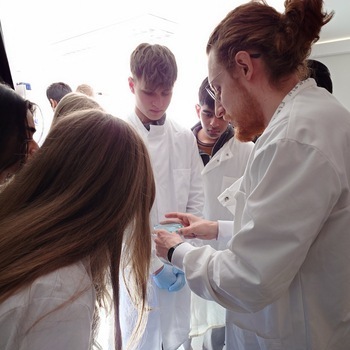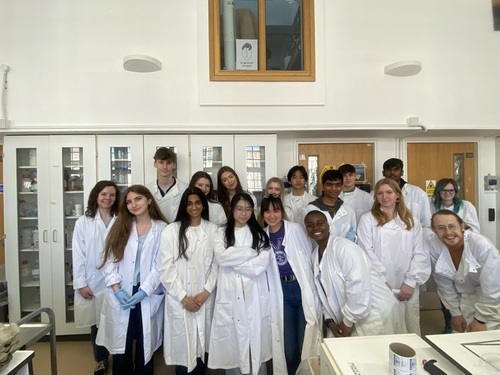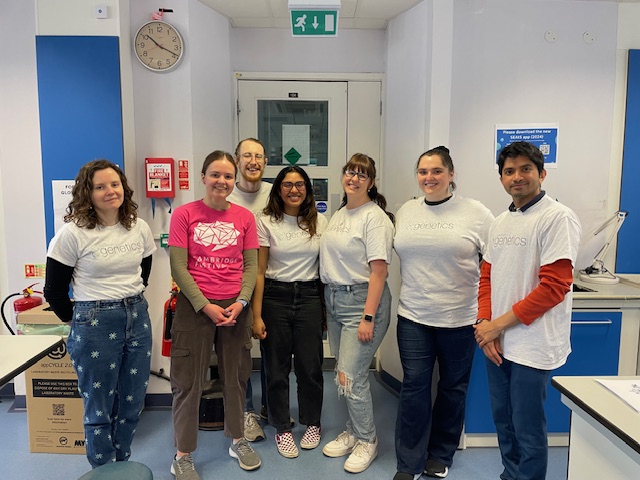Icelandic Visit, August 2025
The Department hosted a visit by 18 students and 5 staff from two Gymnasium schools (Menntaskólinn við Hamrahlíð and Verzlunarskóli College) in Reykajvik Iceland as part of a programme for students to visit science labs and ecosystems outside of Iceland. Organised by Donna Golach from AIOS AI, the aim was to provide the students an opportunity to understand more about how life science research and stimulate their imagination, scientific curiosity and entrepreneurship. During the visit the students heard a short talk from our Head of Department Steve on the history and current structure of the Department along with some personal reflections of his life in science (along with a snapshot of his Bjork record collection). Students then toured the Department to see how real research labs look (in contrast to the glossy brochure presentation of science labs) and explored some of our mutant drosophila lines in the fly lab guided by Tharini Kumar, one of our Postgraduate students. The students enjoyed the visit and asked many insightful questions across the visit. As ever it is always a pleasure to host young people in the Department and open their eyes to the excitement in modern Genetics.
Magdalene College Residential, April 2025
Each year Magdalene College arrange a residential trip for Year 12 students attending state-maintained school in Merseyside of the Isle of Man. A group of these students came to the Department to experience life in the lab. The Steventon Group ran two activities for the students during their visit.
For the chicken activity: the students joined Alex in the main lab to learn how to window a chicken egg: a process that allows you to observe the developing embryo inside. They watched her demonstration before having a go themselves, then identified the major structures they could see at 4 days of development, such as the eyes, brain, tail and limb buds. But the most obvious structure was the heart, pumping blood around an extensive blood vessel network that covers the yolk. One student was even lucky enough to open an egg and find twins – a rare occurrence where two separate embryos develop within the same egg. After windowing, they moved over to the Embryo Room where Bassel showed them how to better visualise the embryos under the dissecting microscopes and label the main structures on a worksheet, all while sharing his extensive knowledge of bird evolution.
For the zebrafish activity: Carlos and Dillan introduced the advantages of working with zebrafish, that they have transparent embryos that are good for imaging, they develop fast, can be easily treated with pharmacological drugs, and we can generate genetically modified animals either mutants or transgenics, we discussed the differences between these two types of genetically modified embryos. We demonstrated how to treat embryos with pharmacological drugs by addition the anaesthetic called tricane to the water to stop early muscular contractions in the embryo. The students then rotated around three stations, examining zebrafish embryos at different times in their development under the microscope guided by one of the team (Dillan, Carlos, Alice, Seun). The students were helped to identify key anatomical features of the embryo such as the yolk, the eye, the tail, and the heart and label these on a worksheet. They were encouraged to think about how this compares to the anatomy of the chicken embryo. The students could also observe the fluorescent signal from several transgenic lines which labelled different anatomical structures or subcellular locations and we discussed with them how you go about making transgenic lines. Finally the students were asked to identify differences between a wildtype embryo and a mutant in the gene cdx4, which results in problems in tail elongation/formation.
Volunteers: Dillan Saunders, Alex Neaverson, Carlos Camacho, Alice Yuen, Bassel Arnaout and Seun Ogundele
Cambridge Festival, March 2025
We had a fantastic team of volunteers help out at this year's Cambridge Festival. On Saturday 29th March we ran various activities including extracting DNA from a strawberry, studying different fly mutations under microscopes, observing chick embyos and making a double helix out of sweets.
Our volunteers were: Alberto Rosello-Diez, Alex Neaverson, Alice Yuen, Amanda Gardiner, Ana Morena Barriga, Dillan Saunders, Helen Fogerty, Joseph Lewis, Maciej Zurowski, Ritwick Sawarkar, Simon Collier, Sneha Parmar, Swanee Douglas and Tharini Kumar.




